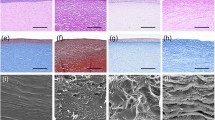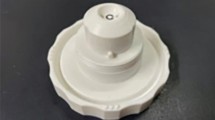Summary
The dehydration of fresh pig corneae are examined under different physical conditions. Speed of drying and dry weight are dependent on temperature and relative humidity of the atmosphere as well as on thickness and diameter of the cornea. Corneal lamellae dry faster if temperatures are high and corneal discs are small and thin. The dry weight of corneal lamellae is low if the relative humidity is low. Silicogel appears to be a better drying agent at low temperatures.
The preservation method of Payrou using Silicagel at room temperature and the method introduced by Urrets-Zavalia who employed drying at 40° C are discussed. Both techniques are compared with other simple methods of dehydration at room temperature without Silicagel and at +45°. The dehydration at +20° or at +45° C is preferable to the dehydration of corneae at lower temperatures. Dried corneae are best stored at low temperatures over Silicagel.
Zusammenfassung
Das Austrocknen von frischen Schweinehornhäuten wird unter verschiedenen physikalischen Bedingungen untersucht. Austrocknungsgeschwindigkeit und Trockengewicht hängen ab von Temperatur, relativer Luftfeuchtigkeit, Hornhautdicke und Hornhautdurchmesser, Hornhautlamellen trocknen schneller, wenn die Trocknungstemperaturen hoch und die Lamellen klein und dünn sind. Das Trockengewicht der Hornhaut liegt niedrig, wenn die relative Feuchtigkeit gering ist. Silikagel scheint ein besseres Trockenmittel bei niedrigen Temperaturen zu sein.
Die Konservierungsmethode von Payrau, in der Silikagel bei Raumtemperaturen verwendet wird und die Methode der Kühlschrankkonservierung von Urrets-Zavalia werden besprochen. Die Methoden werden mit anderen einfachen Konservierungsmethoden verglichen: Die Konservierung bei +20° C ohne Silikagel und die Konservierung bei +45° C. Eine Austrocknung des Gewebes bei +20° C und bei +45° C ist einer Dehydratation bei niedrigeren Temperaturen vorzuziehen. Die Konservierung erfolgt anschließend am besten bei tiefen Temperaturen über Silikagel.
Similar content being viewed by others
Literatur
Davson, H.: Some considerations on the salt content of fresh and old ox cornea. Brit. J. Ophthal.33, 175 (1949).
Davson, H.: The hydration of the cornea. Biochem. J.59, 24 (1955).
Deutman, A. F.: Formalized cornea and keratoplasty in rabbits eyes. Ophthalmologica (Basel)99, 418 (1940).
Duane, T. D.: The steady state of corneal hydration. Amer. J. Ophthal.32, 203 (1949).
Eastcott, H. G., Cross, A. G., Leigh, A. G., North, D. P.: Preservation of corneal grafts by freezing. Lancet1954 I, 237.
Fielding, M. T., Basu, P. K., Ormsby, H. L.: Antigenetic properties of fresh and stored corneal proteins. Amer. J. Ophthal.49, 513 (1960).
Filatow, V. P.: The cornea of the cadaver as material for transplantation. Ann. Oculist. (Paris)171, 721 (1934).
Haseloff, O. W., Hoffmann, H.-J.: Kleines Lehrbuch der Statistik. Berlin: Walter de Gruyter 1968.
Longmire, W. P.: The homologue transplantation of tissues: clinical aspects. J. nat. Cancer Inst.14, 669 (1953).
McNair, I. N., King, I. H.: Preservation of cornea by dehydration. Arch. Ophthal.53, 519 (1955).
Payrau, P.: Hornhautkonservierung und Heteroplastik. Klin. Mbl. Augenheilk.137, 49 (1960).
Payrau, P., Bonel, L., Guyard, M.: Kératoplasties homogènes et hétérogènes practiquées avec des greffons conservés par une méthode de lyophilisation. Ann. Oculist. (Paris)191, 637 (1958).
Payrau, P., Pouliquen, Y.: Conservation des cornées et des sclères par silicodessication. Homogreffes et hétérogreffes. Ann. Oculist (Paris)193, 309 (1960).
Salzer, F.: Über Implantation von isolierter Pferdehornhaut in die Cornea des Kaninchens. Arch. Augenheilk.65, 214 (1910).
Scherschewskaya, O. J.: Keratoplastische Versuche mit Anwendung von Formallappen. Ophthalmologica (Basel)99, 4 (1940).
Stucchi, C. S., Streiff, E. B.: Keratoplasty with deep-frozen homografts. R.R.A. 2nd International Corneo-Plastic Surgery, p. 511 (1967).
Szilagyi, J., Bornemisza, Cy.: Neues Verfahren zur Konservierung von Organen mittels “adsorptiver Lyophilisation”. Zbl. Chir.80, 1129 (1955).
Urrets-Zavalia, A.: Spontaneous desiccation of corneal donor material. Amer. J. Ophthal.57, 247 (1964).
Weskamp, R.: Experimental lamellar keratoplasty with material preserved by spontaneous desiccation. J. int. Coll. Surg.43, 416 (1965).
Author information
Authors and Affiliations
Rights and permissions
About this article
Cite this article
Hofmann, P.G., Mueller, F.O. Zur optimalen Austrocknung von Hornhautlamellen für die lamellare Keratoplastik. Albrecht v Graefes Arch. klin. exp. Ophthal. 184, 99–110 (1972). https://doi.org/10.1007/BF02390258
Received:
Issue Date:
DOI: https://doi.org/10.1007/BF02390258




